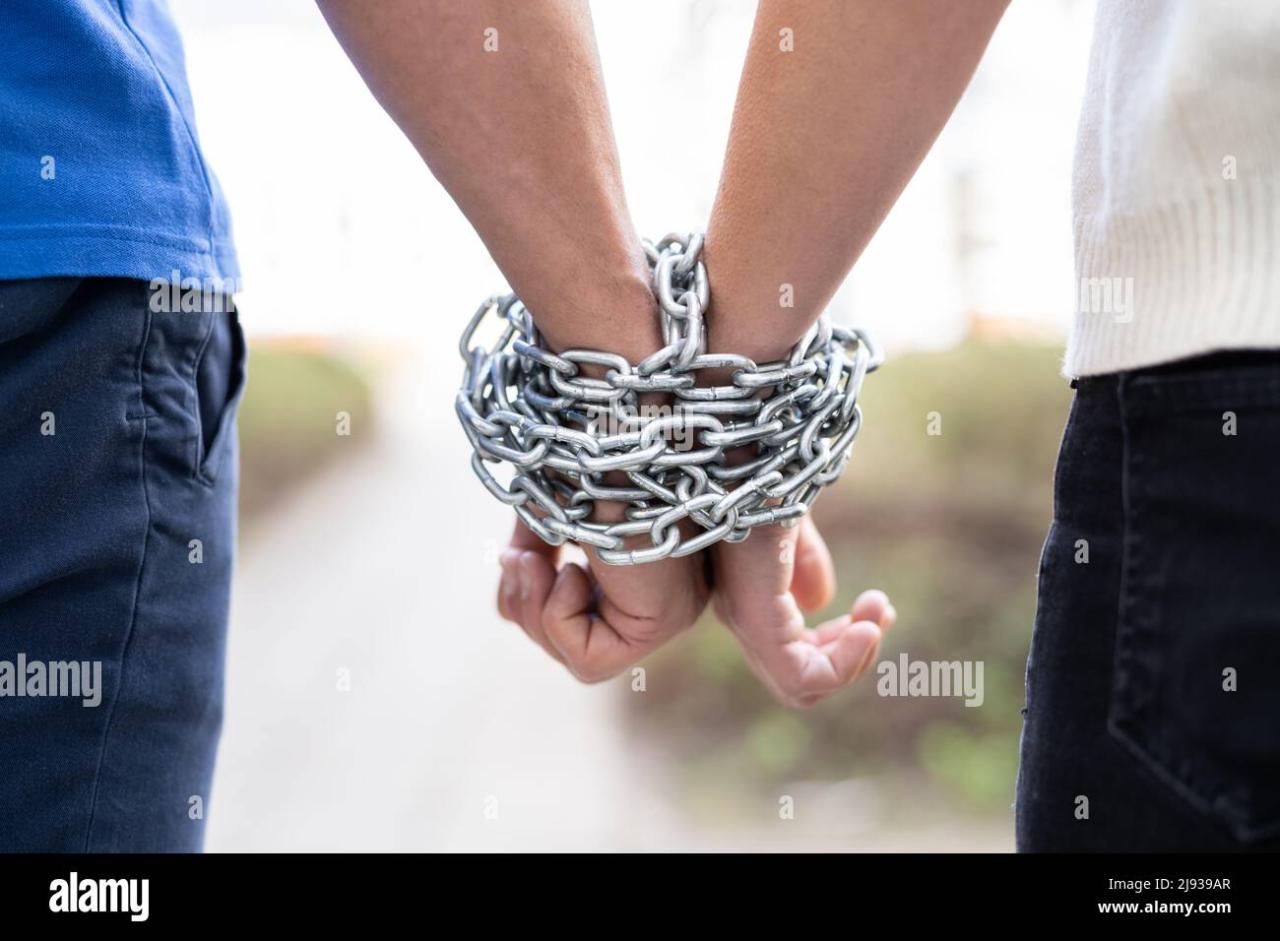Introducing “How High is Chained Together,” a discourse that delves into the multifaceted concept of “chained together,” exploring its origins, physical manifestations, metaphorical interpretations, and its impact on literature, art, psychology, and our very existence. Brace yourself for an analytical journey that unravels the intricate tapestry of this evocative phrase.
From its etymological roots to its profound metaphorical meanings, “chained together” encapsulates a spectrum of experiences and emotions, influencing our self-perception, relationships, and well-being. This discourse will illuminate the ways in which this concept has been expressed through literary works, art forms, and personal narratives.
Origins of Chained Together

The phrase “chained together” has a long and complex history, with roots in both the physical and metaphorical realms. In its most literal sense, the phrase refers to the act of connecting two or more objects with a chain, typically for the purpose of preventing them from moving independently.
This practice has been used for centuries to secure everything from prisoners to livestock, and it continues to be used in a variety of contexts today.
The metaphorical use of the phrase “chained together” is equally old, and it has been used to describe a wide range of relationships, both positive and negative. In some cases, the phrase is used to convey a sense of close connection or interdependence.
For example, two people who are “chained together” by love or friendship may be said to be inseparable. In other cases, the phrase is used to convey a sense of oppression or restriction. For example, someone who is “chained together” to a job or a relationship may feel trapped and unable to move forward.
Etymology
The word “chain” is derived from the Latin word “catena,” which means “a chain.” The word “together” is derived from the Old English word “togaedere,” which means “in company with.” The phrase “chained together” first appeared in the English language in the early 14th century, and it has been used continuously ever since.
Cultural Significance
The phrase “chained together” has been used in a variety of cultural contexts throughout history. In literature, the phrase has been used to describe everything from the bonds of love to the shackles of oppression. In art, the phrase has been used to depict both the beauty and the pain of human relationships.
And in music, the phrase has been used to create songs that explore the themes of connection, separation, and freedom.
Physical Manifestations of Chained Together
The concept of “chained together” can be represented physically in various ways. Objects or situations that embody this idea include:
Interconnectedness
- A chain, with its links physically connected, serves as a prime example of being chained together. Each link is dependent on the others to maintain the chain’s integrity.
- A team of people working on a project, where each individual’s contribution is linked to the overall success of the project.
Constraints and Limitations
- A person handcuffed or shackled, physically restricted and unable to move freely.
- A car stuck in traffic, constrained by the movement of other vehicles and the limitations of the road.
Cause and Effect
- A series of dominoes lined up, where the fall of one domino triggers a chain reaction, causing the fall of subsequent dominoes.
- A financial crisis, where the failure of one institution can lead to a ripple effect, impacting other institutions and the economy as a whole.
Metaphorical Interpretations of Chained Together
The phrase “chained together” carries a range of metaphorical meanings that extend beyond its literal interpretation of physical confinement. It can represent the intricate connections and obligations that bind individuals within relationships, as well as the limitations and restrictions that can hinder personal growth and freedom.
Relationships, How high is chained together
- Interdependence and Support:Chained together can symbolize the mutual dependence and support that exists within relationships. The chains represent the bonds that hold people together, providing stability, security, and emotional sustenance.
- Obligations and Responsibilities:The phrase can also convey the sense of duty and obligation that comes with relationships. The chains represent the commitments and responsibilities that individuals have towards each other, which can be both a source of strength and a burden.
- Emotional Attachment:Chained together can metaphorically depict the deep emotional attachments that develop between people in relationships. The chains symbolize the invisible bonds that connect them on an emotional level, creating a sense of closeness and intimacy.
Limitations and Restrictions
- Personal Growth:Chained together can represent the limitations and restrictions that can hinder personal growth. The chains symbolize the obstacles and challenges that prevent individuals from reaching their full potential, whether due to external circumstances or internal beliefs.
- Freedom and Autonomy:The phrase can also convey the loss of freedom and autonomy that can result from being chained together. The chains represent the constraints that limit individuals’ choices and actions, preventing them from pursuing their own interests and desires.
- Social Conventions:Chained together can metaphorically depict the social conventions and expectations that can restrict individuals’ behavior and choices. The chains represent the invisible bonds that society imposes on individuals, shaping their lives and limiting their freedom.
Literary and Artistic Expressions of Chained Together: How High Is Chained Together
The concept of “chained together” has been explored in numerous literary works and art forms, providing profound insights into its implications and consequences.
In literature, the theme of “chained together” often manifests as a metaphor for oppressive social structures, romantic entanglements, or the burdens of familial relationships. For instance, in Emily Brontë’s novel “Wuthering Heights,” the characters Heathcliff and Catherine are inextricably linked by a passionate yet destructive bond, symbolized by the chains of their shared past and the psychological scars they inflict upon each other.
Novels
- “The Scarlet Letter” by Nathaniel Hawthorne:Explores the theme of social isolation and the burden of guilt through the character of Hester Prynne, who is forced to wear a scarlet “A” as a mark of her adultery.
- “Invisible Man” by Ralph Ellison:Portrays the protagonist’s struggle against societal oppression and the psychological chains of invisibility.
- “Beloved” by Toni Morrison:Examines the lasting impact of slavery and the psychological chains that bind former slaves to their past.
Art
- “The Raft of the Medusa” by Théodore Géricault:Depicts the survivors of a shipwreck chained together on a raft, symbolizing the fragility of human life and the bonds that unite people in times of adversity.
- “The Scream” by Edvard Munch:Captures the psychological anguish and isolation of an individual, evoking the chains of anxiety and despair that can bind us.
- “Guernica” by Pablo Picasso:A powerful anti-war painting that depicts the horrors of bombing and the suffering it inflicts upon those chained together by conflict.
These literary and artistic expressions serve as poignant reminders of the multifaceted nature of the “chained together” concept, exploring its implications for individuals, relationships, and society as a whole.
Psychological and Emotional Impact of Chained Together
Feeling “chained together” can have profound psychological and emotional effects on individuals. This perception of being bound or restricted can manifest in various ways, influencing self-perception, relationships, and overall well-being.
One significant impact is the erosion of self-esteem and confidence. When individuals feel chained together, they may perceive themselves as incapable or unworthy of personal growth and fulfillment. This can lead to feelings of inadequacy, self-doubt, and a diminished sense of self-worth.
Impact on Relationships
Chained togetherness can also strain relationships. The perceived limitations and restrictions can create a sense of resentment, frustration, and distance between individuals. Communication may suffer as individuals struggle to express their true feelings and needs, fearing judgment or disapproval.
Furthermore, it can lead to unhealthy patterns of codependency, where one individual relies excessively on the other for emotional support and validation. This can create an imbalance in the relationship and hinder both individuals from developing healthy and fulfilling relationships with others.
Impact on Well-being
The psychological and emotional toll of feeling chained together can manifest in various physical and mental health issues. Stress, anxiety, and depression are common consequences, as individuals grapple with feelings of helplessness and hopelessness.
Chronic stress can also lead to physical ailments such as headaches, muscle tension, and digestive problems. In severe cases, it can contribute to more serious health conditions like heart disease and stroke.
Overcoming Chained Together
Overcoming the feeling of being “chained together” requires a multifaceted approach involving self-awareness, resilience, and seeking support. Breaking free from this emotional state empowers individuals to regain control over their lives and forge healthier relationships.
Self-Awareness
The journey towards overcoming feelings of being chained together begins with self-awareness. Recognizing the patterns, triggers, and emotions associated with this state is crucial. Journaling, meditation, and introspection can facilitate this process by providing a deeper understanding of one’s thoughts, feelings, and behaviors.
Resilience
Building resilience is essential for overcoming feelings of being chained together. This involves developing the ability to bounce back from setbacks, cope with challenges, and maintain a positive outlook despite adversity. Engaging in self-care practices, setting realistic goals, and seeking support from loved ones can foster resilience.
Seeking Support
Seeking support from trusted individuals, such as friends, family, or a therapist, can provide valuable assistance in overcoming feelings of being chained together. Sharing experiences, gaining new perspectives, and receiving encouragement can empower individuals to break free from negative patterns and forge healthier relationships.
Concluding Remarks

In conclusion, “How High is Chained Together” has shed light on the multifaceted nature of this evocative phrase, exploring its origins, physical manifestations, metaphorical interpretations, and its impact on our psyche and creative expression. By unraveling the complexities of “chained together,” we gain a deeper understanding of the human condition and the myriad ways in which we navigate the bonds that both unite and constrict us.
Query Resolution
What are the psychological implications of feeling “chained together”?
Feeling “chained together” can lead to a diminished sense of autonomy, low self-esteem, and difficulty forming healthy relationships.
How can we overcome feelings of being “chained together”?
Overcoming feelings of being “chained together” requires self-awareness, resilience, and seeking support from trusted individuals or professionals.

